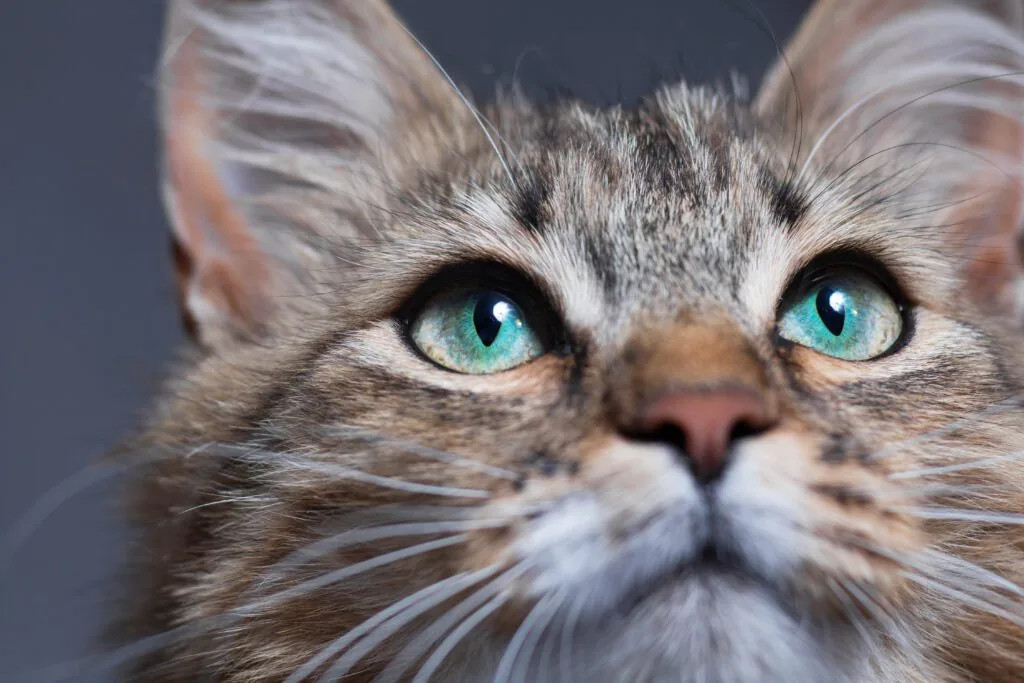Have you ever observed your cat’s eyes glistening with tears and wondered if they were expressing sadness? It’s a common question among cat owners: do cats cry like humans do? At SolCat.net, we understand your concern for your feline friend’s well-being. This article will explore the fascinating world of feline tears, delving into the real reasons behind those watery eyes and what they signify for your cat’s health. Understanding your cat’s health is paramount, and knowing the nuances of feline tears is a key aspect of responsible pet ownership. Let’s investigate why cats produce tears and what it means for their overall health.
 Worried cat owner observing their feline companion's watery eyes, highlighting the question of why cats cry and the importance of veterinary checkups.
Worried cat owner observing their feline companion's watery eyes, highlighting the question of why cats cry and the importance of veterinary checkups.
The Science of Feline Tears: Physiological Necessity vs. Emotional Expression
Cats, much like humans, possess tear ducts and can indeed produce tears. This physiological function is crucial for maintaining optimal eye health in felines. Tears in cats serve a vital purpose: they lubricate the eye surface, preventing dryness and discomfort. Furthermore, tears act as a natural cleansing mechanism, effectively washing away debris, dust, and irritants that may enter the eye. This constant lubrication and cleaning action is essential for protecting the delicate cornea and maintaining clear vision.
However, it’s important to differentiate feline tears from human tears. While humans often shed tears as an emotional response to sadness, joy, or pain, cats do not cry in the same emotional context. When you see your cat’s eyes watering, it’s generally not an indication of emotional distress but rather a sign of a physiological process or potentially an underlying health issue. Understanding this distinction is the first step in properly addressing your cat’s watery eyes.
Unraveling the Common Causes of Watery Eyes in Cats
When you notice your cat’s eyes are tearing up, it could be due to a variety of reasons, ranging from simple environmental factors to more complex health conditions. Identifying the potential cause is crucial for providing appropriate care.
Allergies and Environmental Irritants
Just like humans, cats can suffer from allergies. Common allergens for cats include pollen, dust mites, mold, and certain food ingredients. These allergens can trigger an allergic reaction, leading to inflammation in the eyes and subsequent tearing. Additionally, environmental irritants such as smoke, perfumes, cleaning products, and even dust can irritate a cat’s sensitive eyes, causing them to water as a defense mechanism to flush out the irritating substances.
Eye Infections and Conditions
Various eye infections can cause increased tear production in cats. Viral infections, such as feline herpesvirus, and bacterial infections are common culprits. These infections often cause inflammation of the conjunctiva (the clear membrane covering the white part of the eye and the inner eyelids), leading to conjunctivitis, a condition characterized by redness, swelling, discharge, and excessive tearing.
Furthermore, other eye conditions like blocked tear ducts (which prevent tears from draining properly), corneal ulcers (sores on the surface of the cornea), and entropion (a condition where the eyelid rolls inward, causing eyelashes to irritate the eye) can all result in watery eyes. Even the presence of foreign objects in the eye, such as grass seeds or debris, will trigger tear production as the eye attempts to expel the irritant.
Emotional Stress and Physical Health
While cats don’t cry emotional tears in the human sense, stress and anxiety can manifest in various physical symptoms, and in some cases, this can indirectly affect eye health. A stressed cat might be more prone to certain illnesses that could manifest with watery eyes. However, it’s crucial to rule out direct eye-related causes first before attributing tearing solely to stress.
Recognizing When Feline Tears Signal a Problem
It’s important to be observant of your cat’s tearing and note any accompanying symptoms. While occasional, clear tears might be part of normal eye cleaning, certain signs should prompt concern and a veterinary visit.
Seek veterinary attention if you observe any of the following along with tearing:
- Redness and Swelling: If the white part of your cat’s eye appears red or the eyelids are swollen, it indicates inflammation or infection.
- Discharge: Discharge that is not clear, especially if it’s yellow, green, or pus-like, strongly suggests an infection.
- Squinting or Pawing at the Eye: These are signs of pain and discomfort, indicating a potential injury or eye condition.
- Cloudiness of the Eye: A cloudy cornea can be a sign of a serious corneal ulcer or other eye problem.
- Persistent Tearing: If the tearing is excessive, constant, or doesn’t improve within a day, it warrants veterinary examination.
Ignoring these symptoms can lead to the worsening of underlying conditions and potentially affect your cat’s vision permanently. Early intervention is key to ensuring your feline companion’s long-term eye health.
What to Do When Your Cat Has Watery Eyes: A Step-by-Step Guide
If you notice your cat has watery eyes, taking a measured approach is best. Here are some steps you can take:
- Observe and Monitor: Carefully observe the frequency and severity of the tearing. Note any accompanying symptoms as mentioned above.
- Check the Environment: Ensure your home environment is free from obvious irritants like smoke, strong perfumes, or dusty conditions. Improve ventilation and air quality if possible.
- Gentle Cleaning: If there is mild discharge, you can gently clean around your cat’s eyes with a soft, damp cloth. Use separate cloths for each eye to prevent cross-contamination.
- Avoid Self-Treating: Do not use human eye drops or medications on your cat without veterinary advice, as some can be harmful.
- Consult Your Veterinarian: If the tearing persists, worsens, or is accompanied by concerning symptoms, promptly consult with your veterinarian. A vet can accurately diagnose the cause of the tearing and recommend appropriate treatment, which might include eye drops, ointments, or other medications depending on the diagnosis.
Regular check-ups with your veterinarian are also crucial for maintaining your cat’s overall health, including their eye health.
Prioritizing Your Cat’s Eye Health for a Happy Feline
Understanding why cats produce tears and being able to differentiate between normal tearing and signs of a problem is essential for every cat owner. While cats don’t cry emotionally, their tears play a crucial role in maintaining eye health. By being attentive to your cat’s eyes and seeking timely veterinary care when needed, you can ensure their vision remains clear and their eyes stay healthy, contributing to their overall well-being and happiness. Remember, at solcat.net, we are dedicated to providing you with the information you need to be the best possible caretaker for your feline companion. If you have any concerns about your cat’s eye health, please consult with your veterinarian for professional advice and care.

